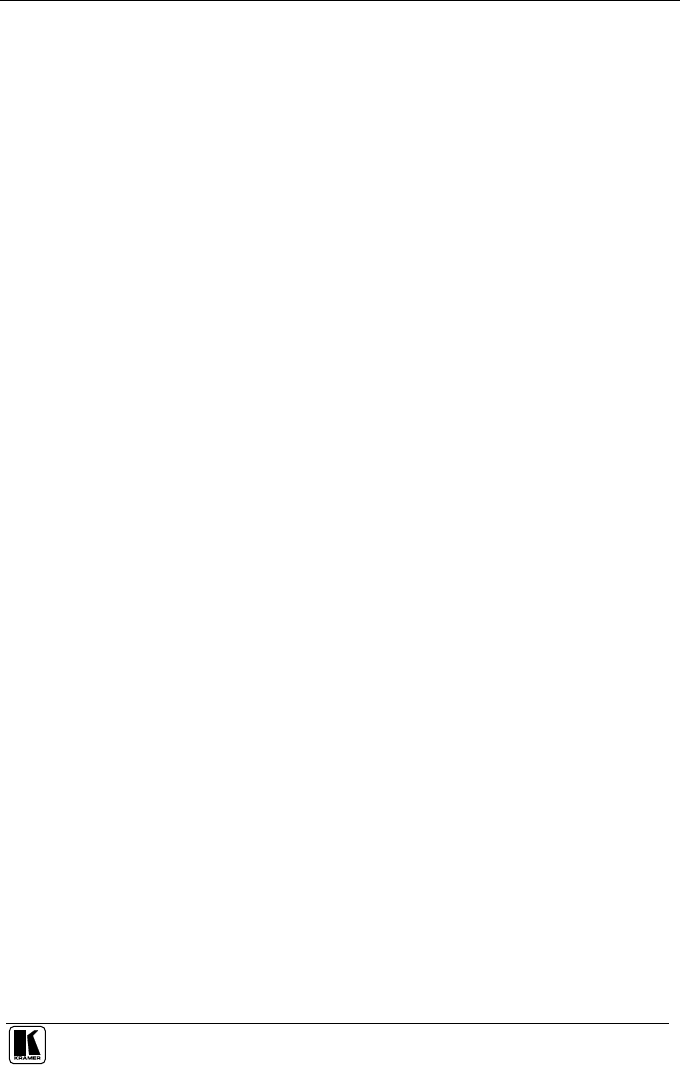
Communication Protocol
23
DETAILS OF INSTRUCTION SET
Instruction 0x00: Reset
When machine is turned on, it sends a Reset code to the PC (0x40 0x80 0x80 0x88).
If this code is sent to the switchers with Byte3 = 0, it will reset according to the present power-down settings. (See instruction
#4 for resetting the PIP to its factory default state).
Instruction 0x01: Input select
Sending this instruction will select the input number that is specified in Byte2.
For example:
To select input 2, send 0x01 0x82 0x80 0x88. The unit responds by sending 0x41 0x81 0x80 0x88
Instruction 0x02: Mode select
Sending this instruction with Byte3 = 0 will set the unit to output a single picture; setting Byte3 to any other value will set the
unit to work in Picture-In-Picture (PIP) mode.
To request the operation mode, set the RQ bit. The unit responds by setting Byte3 appropriately.
For example:
To set for PIP mode, send 0x02 0x80 0x81 0x88.
To find out the operation mode in this case, send 0x02 0xc0 0x80 0x88. The unit responds by sending 0x42 0x80 0x81 0x88.
Instruction 0x03: Store
Sending this instruction with Byte3 = 0 will store the unit's current settings in non-volatile memory. Byte2 selects the
memory address (1 or 2). If Byte3 = 1, then the memory's setting is cleared.
To inquire whether a setting is stored in a memory address, set the RQ bit. The unit responds by setting Byte3 as 0 if data is
saved, or 1 if not.
For example:
To save to memory 2, send 0x03 0x82 0x80 0x88.
To find out if data is stored in memory 2, send 0x03 0xc2 0x80 0x88. Since there is data stored, the unit responds by sending 0x43
0x80 0x80 0x88.
To erase memory 2, send 0x03 0x82 0x81 0x88.
Instruction 0x04: Recall
Sending this instruction with will recall the settings stored in non-volatile memory. Byte2 selects the memory address (1 or
2). To recall the factory reset settings, select byte2 = 0.
There is no inquire (RQ) for this instruction.
For example:
To recall from memory 1, send 0x04 0x81 0x80 0x88.
Instruction 0x09: Video Input Format
Sending this instruction selects the video format (Byte3) for an input (Byte2).
To inquire which video format is selected on an input, set the RQ bit. The unit responds by setting Byte3 appropriately.
For example:
To set input 4 for Y/C, send 0x09 0x84 0x81 0x88.
To find out the video format for input 4 in this case, send 0x09 0xc4 0x80 0x88. The unit responds by sending 0x49 0x84 0x81
0x88.
Instruction 0x0a: Request Video Input Standard
This "instruction" can only be used with the RQ bit set. It is used to inquire which video standard is detected on an input. The
unit responds by setting Byte3 appropriately.
For example:
To inquire which standard is detected on input 3, send 0x0a 0xc3 0x80 0x88. If a PAL-B input is present, then the unit responds by
sending 0x4a 0x83 0x81 0x88.
Instruction 0x0b: Video Output Standard
Sending this instruction selects the video output standard (Byte3).
NOTE: If the unit does not support the standard, then it will return an ERROR code (Instruction 0x10)
To request which video standard has been selected on the output, set the RQ bit. The unit responds by setting Byte3
appropriately.
For example:
To set the machine to output PAL, send 0x0b 0x80 0x81 0x88.
To find out the video format for in this case, send 0x0b 0xc0 0x80 0x88. The unit responds by sending 0x4b 0x80 0x81 0x88.
Instruction 0x10: Error
This is the code returned by the machine if invalid data is received (it is not really an instruction).
For example:
If the user sends 0x01 0x87 0x81 0x88 (ie. he tries to select input # 7 – which is an invalid input number), the unit will respond by
sending 0x50 0x80 0x80 0x88.


















